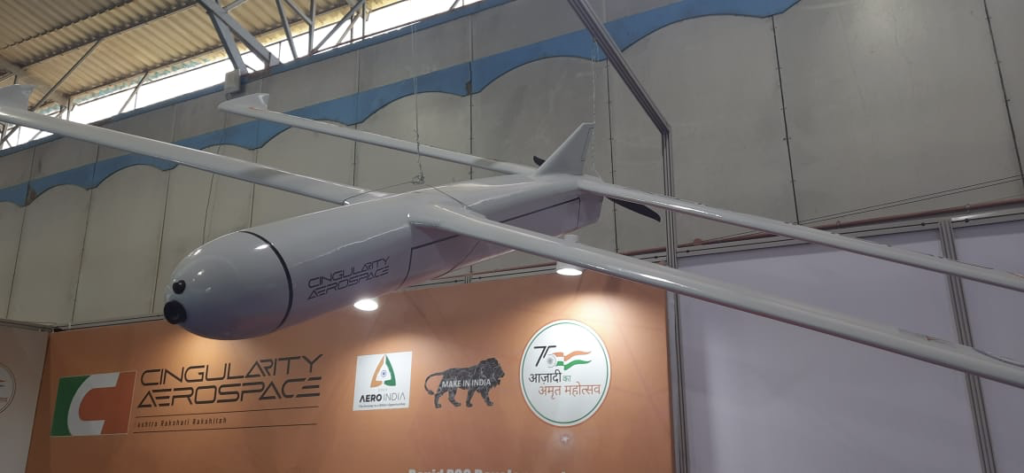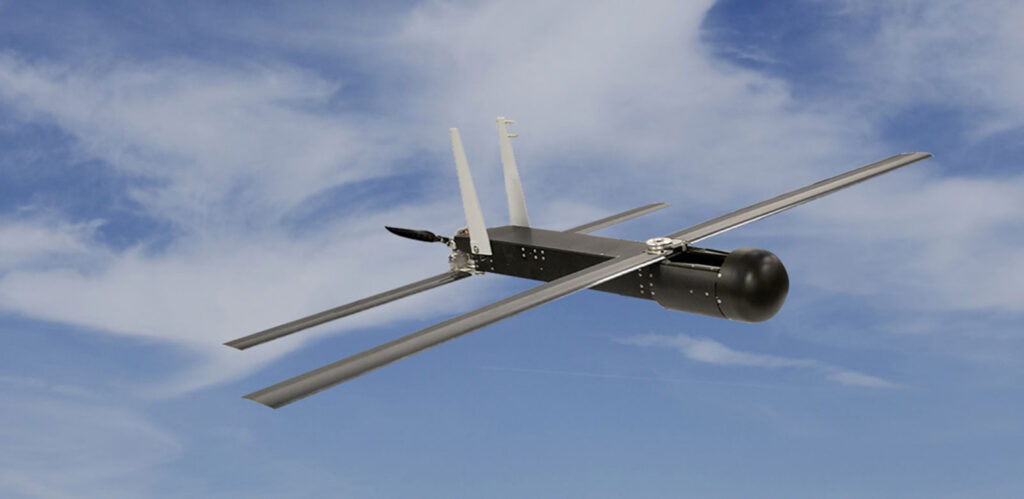– Vaibhav Ugale (UAV Expert)
With the relentless march of technological progress, the landscape of warfare has evolved into a realm of greater sophistication and complexity. Among the most recent advancements in modern warfare, we find the emergence of Loitering Munition drones. These aerial vehicles represent a cost-effective alternative to armed drones, tailored for precise, short-distance strikes. Their operational principle revolves around carrying a warhead while loitering above the battlefield, diligently identifying their intended targets before executing a precise, calculated descent, thereby inflicting damage and destruction upon their designated objectives.
Loitering munitions distinguish themselves through their diminutive and lightweight stature, rendering them elusive adversaries that are challenging to detect. They find strategic utility in engaging targets such as armored vehicles, military outposts, and ammunition storage facilities. Their potential is further augmented through the integration of artificial intelligence, enabling them to orchestrate coordinated operations, notably in the realm of suppression and destruction of enemy air defenses, a domain known by its acronyms SEAD (Suppression of Enemy Air Defenses) and DEAD (Destruction of Enemy Air Defenses).
Within the diverse array of loitering munitions, we encounter various configurations, ranging from fixed-wing and fixed tandem-wing models to expandable tandem-wing designs, multi-rotor configurations, and Vertical Takeoff and Landing (VTOL) variants. Their deployment is equally versatile, spanning methods such as hand launches, pneumatic launchers, catapult systems, canister deployments, and multi-barrel launchers. These drones are equipped with sophisticated electrooptical payloads, encompassing daylight cameras, imaging infra-red seekers, and laser range finders, each crucial for the precise acquisition of targets. Powering their flight are propulsion systems that harness either electric or fuel-based technologies.
While nations like the United States, Israel, Iran, and China currently dominate the realm of loitering munitions technology, countries like India, the United Arab Emirates, and Turkey are making notable strides in catching up with the leaders of this technological race.
The practicality and potency of loitering munitions have been demonstrated on the battlefield during the Nagorno-Karabakh conflict and the ongoing Russia-Ukraine war. In the context of the Nagorno-Karabakh conflict, Azerbaijan effectively employed the Harop loitering munition, a product of the Israeli Aerospace Industry, for the purpose of annihilating Armenian command posts and executing SEAD operations against Armenian Surface-to-Air Missile (SAM) sites, thereby creating a clear pathway for TB-2 ground strikes.
In the ongoing Russia-Ukraine War, Ukrainian forces have harnessed American-made AeroVironment Switchblade-300 and Switchblade-600 models to conduct anti-personnel and anti-armored operations. Simultaneously, Russian forces have relied on Iranian Shahed-136 and Russian Zala Lancet loitering munitions to engage in anti-armored operations and dismantle Ukrainian military installations. Notably, Shahed-136 is capable of being deployed in a swarm attack formation.
An additional, burgeoning category within the domain of unmanned systems involves micro-munition-carrying drones. These readily accessible and cost-effective drones have found utility in short-range operations. With minimal modifications and the integration of micro-munitions, these drones are primed for roles in anti-personnel engagements and confrontations with lightly armored military vehicles. Ukrainian forces, for instance, have effectively employed these drone types against Russian military personnel.
Presently, numerous Indian companies are actively engaged in the development and testing of loitering munitions, micro-munition-carrying drones, and micro-munitions. We have curated a selection of these companies and their respective products, based on publicly available information:
NewSpace Research and Technologies
ALFA (Autonomous Loitering Flexible Assets)
- Part of the Combat Air Teaming Systems (CATS)
- Launchable from air platforms, glide pods, or canisters
- Swarming capabilities
- Service ceiling: 6 kilometers
- Range: 160 kilometers
- Endurance: Greater than 60 minutes

TIA-AV (Tactical Interdiction and Attack Air Vehicle)

Mackerel (Multirotor Kamikaze drone launched from mothership drone)

NIMBUS MK-3
- Heterogeneous Swarming UAV

SARPA (Swarm Adaptable Reconnaissance & Precision Attack)

Unknown (Micro-Munition)

Bharat Dynamics Limited – NewSpace Research and Technologies
Hexacopter (Micro-Munitions carrying Drone)

Tata Advanced Systems Limited
ALS-50
- Weight: Less than 50 kilograms
- Range: 50+ kilometers
- Endurance: 60+ minutes
- VTOL capability
- Multiple warhead options
- Operation in GPS-denied environments
- Anti-jamming capability
- Abort and re-engage option

Solar Industries – (Zmotion/ Economic Explosive Limited)
Nagastra-1/Trinetra
- Range: 15 kilometers
- Endurance: 60 minutes
- Warhead: 1-1.5 kilograms
- Cruise speed: 20 meters per second
- High explosive fragmenting warhead for soft-skin targets and top-attack anti-armored warhead for combat vehicles
- Abort option
- Parachute recovery


Nagastra-2
- Range: 25 kilometers
- Endurance: 90 minutes
- Weight: Less than 25 kilograms
- Anti-jamming capability
- Anti-armor operation

Rudrastra (Micro-Munitions carrying Drone)
- Range: 10 kilometers
- Endurance: 30 minutes
- Payload capacity: 5 kilograms

Raphe mPhibr
MR-10 (Micro-Munitions carrying Drone)
- Endurance: 3 hours
- Range: 50 kilometers
- Payload capacity: 10 kilograms
- Operational altitude: Up to 12,000 feet AMSL
- Speed: 60 kilometers per hour
- Day and night camera
- Anti-jamming capability
- Swarming capable

Bharat (Micro-Munitions carrying Drone)
- Payload Capacity: 4 kilograms
- Endurance: 45 minutes

Unknown (Micro-Munition)

Redon Systems
Achuk
- Range: 30 kilometers
- Operational Altitude: 3 kilometers
- Warhead: 1.5 kilograms
- Operation in GPS-denied environments
- Swarming capable
- Pneumatic canister launch system

Cingularity Aerospace
Sierra Tango
- Warhead: 7 kilograms
- Endurance: 2-2.5 hours
- Catapult launch system
- Detachable wings

Kadet Defence Systems
JX-2 Ng
- Range: 400 kilometers
- Speed: 200 kilometers per hour
- Payload: 10 kilograms
- Swarming capable
- Catapult launch

Anudishya
– Range: More than 300 kilometers
– Speed: 125 meters per second (450 kilometers per hour)
– Payload Capacity: 20 kilograms
– Swarming Capable
– Catapult launch

JXV-100 ASADS (Micro-Munitions carrying Drone)
- Range: 40 kilometers
- Endurance: 45 minutes
- Payload: 6 kilograms

Johnnette Technologies
JM-1
- Range: 17 kilometers
- Endurance: 60 minutes
- Payload: 500 grams (Camera + HE-Frag Warhead)
- Pneumatic Launcher

Garuda Aerospace
Vajra
- Range: 160 kilometers
- Endurance: 6 hours
- Cruise Speed: 25 meters per second
- Payload: 10 kilograms

Paras Aerospace
Archer (Micro-Munitions carrying Drone)
- Range: 20 kilometers
- Endurance: 40 minutes
- Payload: 10 kilograms

Hawking Defence
Balidan Micro Drone
- Video feed range: 5 kilometers
- Endurance: 20 minutes
- Speed: 120 kilometers per hour
- Swarming Capable

Bharat Dynamics Limited
Micro-Munitions
- UAV Launched Precision Guided Munitions (ULPGM)
- >3-4 kilometers range missile
- 1.5 kilometers range missile
- 1-kilogram unguided bomb
- 3.5-kilogram unguided bomb

Veda Aeronautics
Veda-X
- Swarming Capable

These developments within the domain of loitering munitions and micro-munitions-carrying drones underscore the rapid evolution and diversification of unmanned systems in the contemporary theater of warfare. This burgeoning field promises to shape the future of military strategy and engagement, offering an array of options to suit an array of operational requirements.
